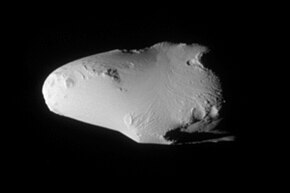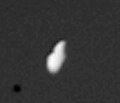 Calypso image from
Cassini (February 13, 2010) | |
| Discovery | |
|---|---|
| Discovered by |
|
| Discovery date | March 13, 1980 |
| Designations | |
Designation | Saturn XIV |
| Pronunciation | /kəˈlɪpsoʊ/ [1] |
Named after | Καλυψώ Kalypsō |
| Tethys C S/1980 S 25 | |
| Adjectives | Calypsoan /kælɪpˈsoʊ.ən/, [2] Calypsonian /kælɪpˈsoʊniən/ [3] |
| Orbital characteristics | |
| 295000 km [4] | |
| Eccentricity | 0.001 [4] |
| 1.887803 d [4] | |
| Inclination | 1.56° (to Saturn's equator) |
| Satellite of | Saturn |
| Group | L5 Tethys trojan |
| Physical characteristics | |
| Dimensions | 29.4 × 18.6 × 12.8 km (± 0.6 × 1.8 × 0.6 km) [5]: 2 |
Mean diameter | 19.0±0.8 km [5]: 2 |
| Volume | 3591 km3 [a] |
| Mass | ≈ 2×1015 kg (assumed; unmeasured) [b] |
Mean
density | ≈ 0.5 g/cm3 (assumed; unmeasured) [5]: 3 |
| ≈ 0.0009–0.0013 m/s2 [5]: 3 | |
| ≈ 0.004 km/s at longest axis to ≈ 0.006 km/s at poles | |
| synchronous | |
| zero | |
| Albedo | 1.34±0.10 ( geometric) [6] |
Calypso is a moon of Saturn. It was discovered in 1980, from ground-based observations, by Dan Pascu, P. Kenneth Seidelmann, William A. Baum, and Douglas G. Currie, and was provisionally designated S/1980 S 25 (the 25th satellite of Saturn discovered in 1980). [7] Several other apparitions of it were recorded in the following months: S/1980 S 29, S/1980 S 30, [8] S/1980 S 32, [9] and S/1981 S 2. [10] In 1983 it was officially named after Calypso of Greek mythology. [c] It is also designated Saturn XIV or Tethys C.
Calypso is co-orbital with the moon Tethys, and resides in Tethys' trailing Lagrangian point ( L5), 60 degrees behind Tethys. This relationship was first identified by Seidelmann et al. in 1981. [11] The moon Telesto resides in the other (leading) Lagrangian point of Tethys, 60 degrees in the other direction from Tethys. Calypso and Telesto have been termed "Tethys trojans", by analogy to the trojan asteroids, and are half of the four presently known trojan moons.
Like many other small Saturnian moons and small asteroids, Calypso is irregularly shaped, has overlapping large craters, and appears to also have loose surface material capable of smoothing the craters' appearance. Its surface is one of the most reflective (at visual wavelengths) in the Solar System, with a visual geometric albedo of 1.34. [6] This very high albedo is the result of the sandblasting of particles from Saturn's E-ring, a faint ring composed of small, water-ice particles generated by Enceladus' south polar geysers. [12]
Gallery
-
Another February 13, 2010 image showing flow-like albedo features
-
Cassini image from September 23, 2005
-
Calypso as seen by Voyager 2 (August 1981)
See also
Notes
- ^ Calculated from Calypso's volume-equivalent sphere radius of 9.5±0.4 km given by Thomas et al. (2020) [5]: 2
- ^ Calculated by multiplying Calypso's volume with its assumed density of 500 kg/m3.
- ^ Transactions of the International Astronomical Union, Vol. XVIIIA, 1982 (confirms Janus, names Epimetheus, Telesto, Calypso) (mentioned in IAUC 3872: Satellites of Jupiter and Saturn, September 30, 1983)
References
Citations
- ^ "Calypso". Lexico UK English Dictionary. Oxford University Press. Archived from the original on March 22, 2020.
- ^ The Emerson Society Quarterly, vol. 50, p. 56, 1968
- ^ "Calypsonian". Lexico UK English Dictionary UK English Dictionary. Oxford University Press. Archived from the original on March 22, 2020.
- ^ a b c "Planetary Satellite Mean Orbital Parameters". Jet Propulsion Laboratory. Retrieved 5 June 2023.
- ^ a b c d e Thomas & Helfenstein 2020.
- ^ a b Verbiscer French et al. 2007.
- ^ IAUC 3496.
- ^ IAUC 3549.
- ^ IAUC 3605.
- ^ IAUC 3593.
- ^ Seidelmann Harrington et al. 1981.
- ^ Mason 2010.
Sources
- Marsden, Brian G. (July 31, 1980). "Satellites of Saturn" (discovery). IAU Circular. 3496. Retrieved 2011-12-23.
- Marsden, Brian G. (December 11, 1980). "Satellites of Saturn". IAU Circular. 3549. Retrieved 2011-12-23.
- Marsden, Brian G. (April 16, 1981). "Satellites of Saturn". IAU Circular. 3593. Retrieved 2011-12-23.
- Marsden, Brian G. (May 18, 1981). "Satellites of Saturn". IAU Circular. 3605. Retrieved 2011-12-23.
- Marsden, Brian G. (September 30, 1983). "Satellites of Jupiter and Saturn". IAU Circular. 3872. Archived from the original on 2011-07-25. Retrieved 2011-12-23.
- Mason, Betsy (February 15, 2010). "New Close-Ups of Saturn's Moons Mimas and Calypso". wired.com. Condé Nast Digital. Retrieved 2011-12-23.
- Seidelmann, P. K.; Harrington, R. S.; Pascu, D.; Baum, W. A.; Currie, D. G.; Westphal, J. A.; Danielson, G. E. (1981). "Saturn satellite observations and orbits from the 1980 ring plane crossing". Icarus. 47 (2): 282. Bibcode: 1981Icar...47..282S. doi: 10.1016/0019-1035(81)90172-X.
- Thomas, P. C. (July 2010). "Sizes, shapes, and derived properties of the saturnian satellites after the Cassini nominal mission" (PDF). Icarus. 208 (1): 395–401. Bibcode: 2010Icar..208..395T. doi: 10.1016/j.icarus.2010.01.025. Archived from the original (PDF) on 2018-12-23. Retrieved 2015-09-04.
- Verbiscer, A.; French, R.; Showalter, M.; Helfenstein, P. (9 February 2007). "Enceladus: Cosmic Graffiti Artist Caught in the Act". Science. 315 (5813): 815. Bibcode: 2007Sci...315..815V. doi: 10.1126/science.1134681. PMID 17289992. S2CID 21932253. Retrieved 20 December 2011. (supporting online material, table S1)
- Thomas, P. C.; Helfenstein, P. (July 2020). "The small inner satellites of Saturn: Shapes, structures and some implications". Icarus. 344: 20. Bibcode: 2020Icar..34413355T. doi: 10.1016/j.icarus.2019.06.016. S2CID 197474587. 113355.


